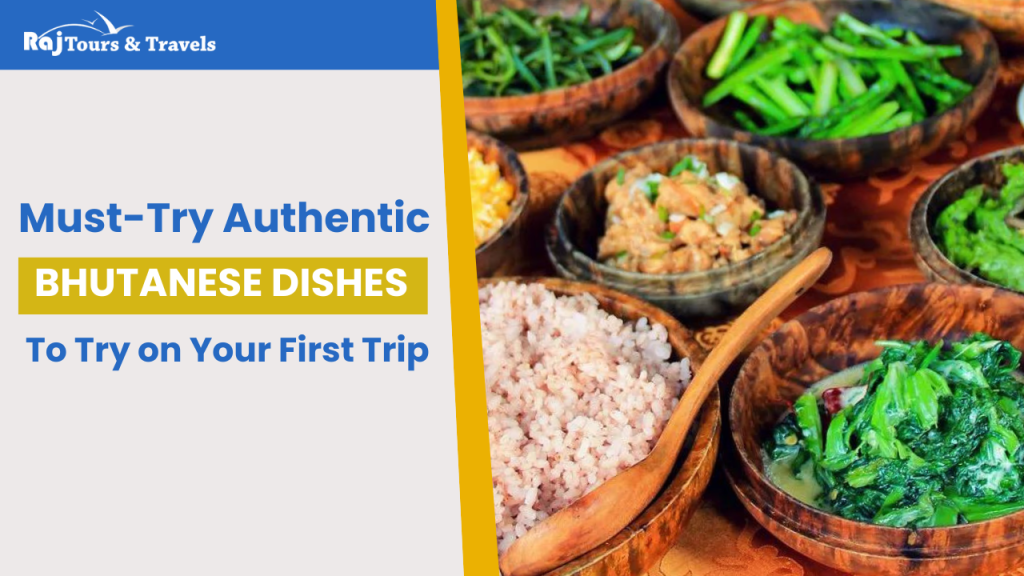Bhutan, the Land of the Thunder Dragon, is not only a destination of breathtaking landscapes and rich culture but also a culinary paradise waiting to be discovered. As you embark on your first trip to Bhutan, one of the most enriching experiences you can have is indulging in its authentic cuisine. Bhutanese food is a reflection of the country’s unique culture, traditions, and the harsh mountainous environment. It’s rich in flavors, with a blend of spices, dairy, and fresh produce that creates a culinary experience like no other.
In this blog, we’ll take you through some of the most popular Bhutanese dishes that you simply must try on your first trip to Bhutan. From the fiery and flavorful to the mild and comforting, these dishes offer a delicious glimpse into Bhutanese life and culture. At Raj Tours and Travels, we believe that experiencing local cuisine is an essential part of any journey, and we’re excited to guide you through Bhutan’s culinary landscape.
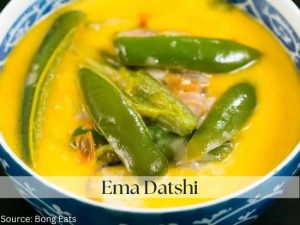
1. Ema Datshi: The National Dish of Bhutan
No culinary exploration of Bhutan is complete without trying Ema Datshi, the national dish of the country. The name “Ema Datshi” literally translates to “chili and cheese,” and it’s exactly what it sounds like – a spicy dish made from green or red chili peppers and cheese.
A. What Makes Ema Datshi Unique?
- Ingredients: The primary ingredients are green or red chilies (ema) and a type of local cheese called datshi, which is similar to cottage cheese but creamier. It is often garnished with onions and tomatoes.
- Flavor Profile: Ema Datshi is known for its heat, as Bhutanese people love their chilies. The cheese adds a creamy texture, balancing the spiciness of the chilies.
- Serving: This dish is typically served with red or white rice, making it a staple in every Bhutanese household.
B. Variations of Ema Datshi
While the classic Ema Datshi is made with chilies and cheese, there are several variations to explore:
- Kewa Datshi: Made with potatoes instead of chilies, it’s a milder version of the dish.
- Shamu Datshi: This variation includes mushrooms along with the chilies and cheese.
- Sikam Datshi: A heartier version that includes sun-dried pork (sikam) with the chilies and cheese.
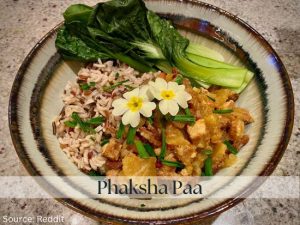
2. Phaksha Paa: Spicy Pork with Radish
Phaksha Paa is a popular Bhutanese dish that features tender slices of pork cooked with dried chilies and radishes. It’s a hearty and flavorful dish that showcases Bhutan’s love for pork and spice.
A. Key Ingredients
- Pork: The dish is made using slices of pork belly, which adds richness and depth to the dish.
- Radish: White radishes are commonly used, adding a crunchy texture that contrasts well with the tender pork.
- Chilies and Spices: Dried red chilies are used generously, and the dish is flavored with Bhutanese spices.
B. Serving and Accompaniments
Phaksha Paa is usually served with rice and sometimes accompanied by a side of Ema Datshi or other vegetable dishes. The combination of spicy pork, radish, and the heat from the chilies makes it a comforting dish, especially during the cold Bhutanese winters.
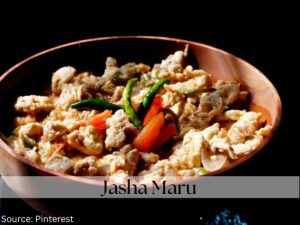
3. Jasha Maroo or Maru: Spicy Chicken Stew
For those who enjoy chicken, Jasha Maroo is a dish not to be missed. This spicy Bhutanese chicken stew is both flavorful and satisfying, making it a favorite among locals and visitors alike.
A. Ingredients and Preparation
- Chicken: Diced or minced chicken is used as the base for this dish.
- Tomatoes and Onions: These are key ingredients that add to the stew’s richness and texture.
- Chilies: As with most Bhutanese dishes, Jasha Maroo is spiced with fresh or dried chilies.
- Spices: Garlic, ginger, and coriander are commonly used to enhance the flavor.
B. How It’s Served
Jasha Maroo is often served with rice and can be accompanied by other side dishes such as spinach or potatoes. The dish has a rich, soupy consistency and can be made as spicy or mild as desired.
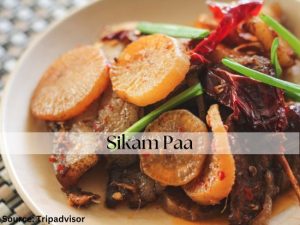
4. Sikam Paa: Dried Pork with Chilies
Sikam Paa is another beloved pork dish in Bhutan, known for its use of sun-dried pork belly. The drying process gives the pork a unique texture and flavor, which is then cooked with dried chilies.
A. Preparation Process
- Sun-Dried Pork: The pork belly is usually sun-dried, which helps preserve it and adds a chewy texture.
- Cooking: The dried pork is then cooked with dried chilies and sometimes with vegetables like radish or spinach.
- Flavors: The dish is rich in flavor, with the chilies providing a spicy kick and the pork offering a savory taste.
B. Traditional Serving Style
Sikam Paa is typically served with rice and often accompanied by Ema Datshi or other vegetable dishes. It’s a hearty meal that is particularly popular during festivals and celebrations.
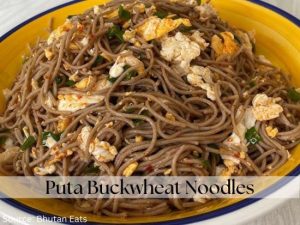
5. Puta: Buckwheat Noodles
In the colder regions of Bhutan, buckwheat is a common crop, and one of the most popular dishes made from it is Puta, or buckwheat noodles. This simple yet nutritious dish is a staple in the Bumthang region of Bhutan.
A. How It’s Made
- Buckwheat Noodles: The noodles are made from buckwheat flour, which gives them a distinct nutty flavor and a slightly chewy texture.
- Preparation: The noodles are usually boiled and then stir-fried with onions, garlic, and a variety of vegetables. Sometimes, they are served with a side of curry or stew.
B. Nutritional Value
Puta is a healthy alternative to wheat-based noodles, as buckwheat is rich in fiber, protein, and essential nutrients. It’s a great option for those looking to try something different and nutritious during their Bhutan trip.
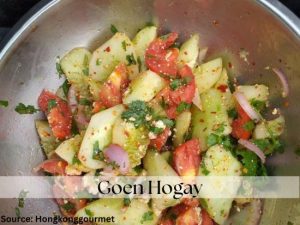
6. Goen Hogay: Bhutanese Cucumber Salad
For a lighter option, especially during the warmer months, Goen Hogay is a refreshing Bhutanese cucumber salad that offers a perfect balance of flavors.
A. Ingredients
- Cucumbers: Fresh cucumbers are the main ingredient in this salad.
- Tomatoes: Often included to add a bit of sweetness.
- Chilies: Fresh green chilies are used to add a spicy kick.
- Cheese: A bit of local cheese or datshi is crumbled into the salad for added flavor.
- Dressing: The salad is typically dressed with a mixture of chili powder, salt, and sometimes Sichuan pepper.
B. Serving Suggestions
Goen Hogay is usually served as a side dish and pairs well with heavier dishes like Ema Datshi or Phaksha Paa. It’s a great palate cleanser and a healthy addition to any meal.
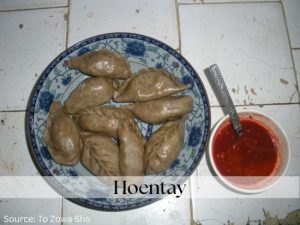
7. Hoentay: Buckwheat Dumplings
Hoentay is a popular dish in the Haa Valley of Bhutan, where it is traditionally prepared during local festivals. These dumplings are made with buckwheat flour and filled with a mixture of spinach, cheese, and turnip greens.
A. Ingredients and Filling
- Dough: Made from buckwheat flour, the dough is rolled out into thin circles.
- Filling: The filling typically consists of spinach, datshi cheese, turnip greens, and sometimes mushrooms or onions.
- Cooking: The dumplings are steamed until soft and served hot.
B. Eating Hoentay
Hoentay is often served with a side of spicy chili sauce or a light soup. These dumplings are not only delicious but also reflect the traditional way of cooking in Bhutan’s colder regions.
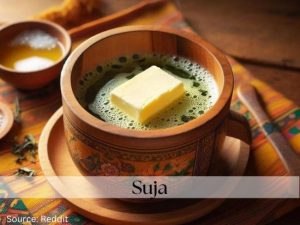
8. Suja: Bhutanese Butter Tea
A unique beverage you must try in Bhutan is Suja, also known as Bhutanese butter tea. Unlike the sweet milk tea common in many parts of the world, Suja has a savory, buttery flavor that is an acquired taste for many visitors.
A. Preparation Process
- Butter: The tea is made by churning butter, usually yak butter, with tea leaves and salt.
- Tea Leaves: Special Bhutanese tea leaves are used, which give the tea its distinct flavor.
- Salt: Salt is added instead of sugar, making this tea savory rather than sweet.
B. Cultural Significance
Suja is more than just a drink; it’s an integral part of Bhutanese hospitality and is often served during ceremonies, to guests, or simply as a warming beverage on cold days.
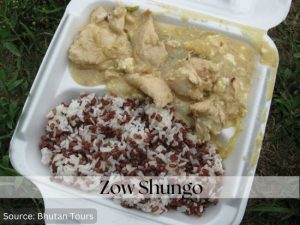
9. Zow Shungo: Leftover Rice Dish
Bhutanese cuisine is known for its resourcefulness, and Zow Shungo is a perfect example. This dish is made using leftover rice and vegetables, often mixed with butter and spices to create a comforting meal.
A. Ingredients
- Rice: Leftover red or white rice is typically used.
- Vegetables: Any leftover vegetables, such as potatoes, carrots, or spinach, are added to the dish.
- Butter and Spices: Butter is used to sauté the vegetables and rice, and a blend of spices is added for flavor.
B. How It’s Enjoyed
Zow Shungo is often eaten as a breakfast dish or a light meal. It’s a great way to use up leftovers and is a testament to the Bhutanese philosophy of minimizing waste.
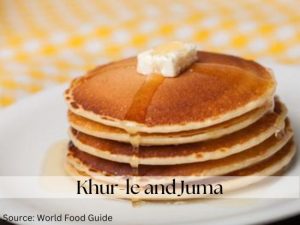
10. Desserts: Khur-le and Juma
While Bhutanese cuisine isn’t particularly known for its desserts, there are a couple of sweet treats you should try:
A. Khur-le: Bhutanese Pancakes
- Ingredients: Made from wheat or buckwheat flour, Khur-le are traditional Bhutanese pancakes.
- Serving: These pancakes are often eaten for breakfast or as a snack, served with tea or butter.
B. Juma: Bhutanese Sausages
- Ingredients: Juma sausages are made from minced meat, rice, and spices, encased in natural sausage casings.
- Flavor: The sausages are mildly spiced and can be served as part of a meal or as a snack.
Bhutanese cuisine offers a rich and diverse culinary experience that is deeply rooted in the country’s culture and traditions. From the spicy and comforting Ema Datshi to the refreshing Goen Hogay, each dish tells a story of Bhutan’s unique way of life. As you travel through Bhutan, take the time to explore its food, as it will give you a deeper understanding of the people and their connection to the land.
Whether you’re a seasoned foodie or simply someone looking to try something new, Bhutan’s authentic cuisine is sure to leave a lasting impression. So, as you plan your first trip to Bhutan, make sure to add these must-try dishes to your itinerary. Your taste buds will thank you for it!
Safe travels and happy eating!

